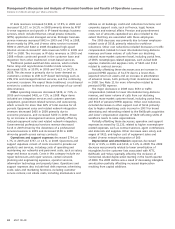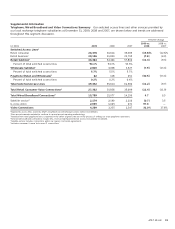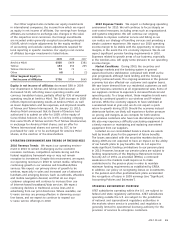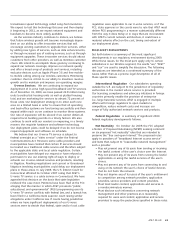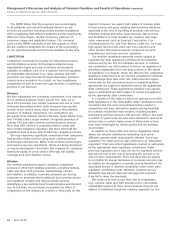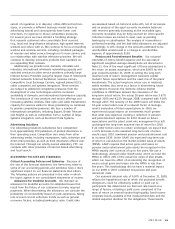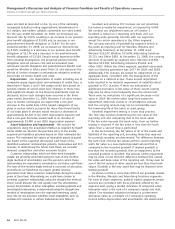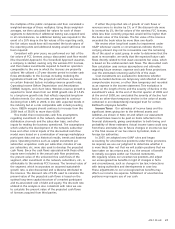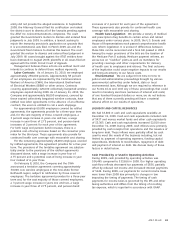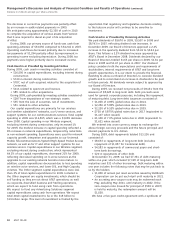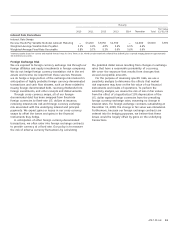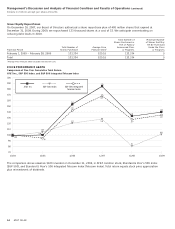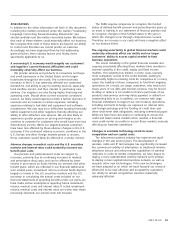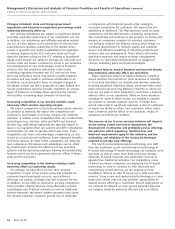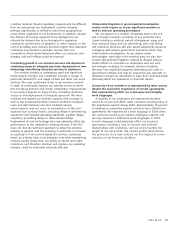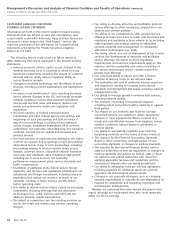AT&T Wireless 2009 Annual Report Download - page 50
Download and view the complete annual report
Please find page 50 of the 2009 AT&T Wireless annual report below. You can navigate through the pages in the report by either clicking on the pages listed below, or by using the keyword search tool below to find specific information within the annual report.
Management’s Discussion and Analysis of Financial Condition and Results of Operations (continued)
Dollars in millions except per share amounts
48 AT&T 09 AR
OTHER BUSINESS MATTERS
Retiree Phone Concession Litigation In May 2005, we were
served with a purported class action in U.S. District Court,
Western District of Texas (Stoffels v. SBC Communications Inc.),
in which the plaintiffs, who are retirees of Pacific Bell
Telephone Company, Southwestern Bell and Ameritech,
contend that the telephone concession provided by the
company is, in essence, a “defined benefit plan” within the
meaning of ERISA, as amended. In October 2006, the Court
certified two classes. The issue of whether the concession
is an ERISA pension plan was tried before the judge in
November 2007. In May 2008, the court ruled that the
concession was an ERISA pension plan. We asked the court to
certify this ruling for interlocutory appeal, and in August 2008,
the court denied our request. In May 2009, we filed a motion
for reconsideration with the trial court. That motion is
pending. A trial on the appropriate remedy has been set for
June 1, 2010. We believe that an adverse outcome having
a material effect on our financial statements in this case
is unlikely, but we will continue to evaluate the potential
impact of this suit on our financial results as it progresses.
NSA Litigation Twenty-four lawsuits were filed alleging
that we and other telecommunications carriers unlawfully
provided assistance to the National Security Agency (NSA) in
connection with intelligence activities that were initiated
following the events of September 11, 2001. In the first filed
case, Hepting et al v. AT&T Corp., AT&T Inc. and Does 1-20,
a purported class action filed in U.S. District Court in the
Northern District of California, plaintiffs alleged that the
defendants disclosed and are currently disclosing to the
U.S. Government content and call records concerning
communications to which Plaintiffs were a party. Plaintiffs
sought damages, a declaratory judgment, and injunctive relief
for violations of the First and Fourth Amendments to the
United States Constitution, the Foreign Intelligence
Surveillance Act (FISA), the Electronic Communications Privacy
Act, and other federal and California statutes. We filed a
motion to dismiss the complaint. The United States asserted
the “state secrets privilege” and related statutory privileges
and also filed a motion asking the court to dismiss the
complaint. The Court denied the motions, and we and the
United States appealed. In August 2008, the U.S. Court of
Appeals for the Ninth Circuit remanded the case to the district
court without deciding the issue in light of the passage of the
FISA Amendments Act, a provision of which addresses the
allegations in these pending lawsuits (immunity provision).
The immunity provision requires the pending lawsuits to be
dismissed if the Attorney General certifies to the court either
that the alleged assistance was undertaken by court order,
certification, directive, or written request or that the telecom
New Accounting Standards
Revenue Arrangements with Multiple Deliverables In
October 2009, the Financial Accounting Standards Board
(FASB) issued “Multiple-Deliverable Revenue Arrange ments”
(Accounting Standards Update (ASU) 2009-13), which
addresses how revenues should be allocated among all
products and services included in our sales arrangements. It
establishes a selling price hierarchy for determining the selling
price of each product or service, with vendor-specific
objective evidence (VSOE) at the highest level, third-party
evidence of VSOE at the intermediate level, and a best
estimate at the lowest level. It replaces “fair value” with
“selling price” in revenue allocation guidance, eliminates the
residual method as an acceptable allocation method, and
requires the use of the relative selling price method as the
basis for allocation. It also significantly expands the disclosure
requirements for such arrangements, including, potentially,
certain qualitative disclosures. ASU 2009-13 will be effective
prospectively for sales entered into or materially modified in
fiscal years beginning on or after June 15, 2010 (i.e., the year
beginning January 1, 2011, for us). The FASB permits early
adoption of ASU 2009-13, applied retrospectively, to the
beginning of the year of adoption. We are currently evaluating
the impact on our financial position and results of operations.
Software In October 2009, the FASB issued “Certain
Revenue Arrangements That Include Software Elements”
(ASU 2009-14), which clarifies the guidance for allocating and
measuring revenue, including how to identify software that is
out of the scope. ASU 2009-14 amends accounting and
reporting guidance for revenue arrangements involving both
tangible products and software that is “more than incidental
to the tangible product as a whole.” That type of software and
hardware will be outside of the scope of software revenue
guidance, and the hardware components will also be outside
of the scope of software revenue guidance and may result in
more revenue recognized at the time of the hardware sale.
Additional disclosures will discuss allocation of revenue to
products and services in our sales arrangements and the
significant judgments applied in the revenue allocation
method, including impacts on the timing and amount of
revenue recognition. ASU 2009-14 will be effective prospec-
tively for revenue arrangements entered into or materially
modified in fiscal years beginning on or after June 15, 2010
(i.e., the year beginning January 1, 2011, for us). ASU 2009-14
has the same effective date, including early adoption
provisions, as ASU 2009-13. Companies must adopt
ASU 2009-14 and ASU 2009-13 at the same time. We are
currently evaluating the impact on our financial position
and results of operations.
See Note 1 for a discussion of recently issued or adopted
accounting standards.


